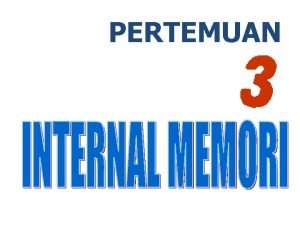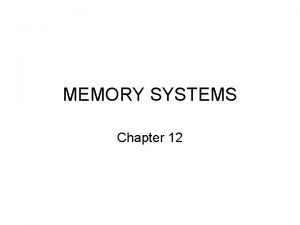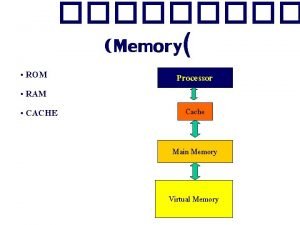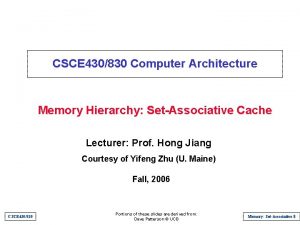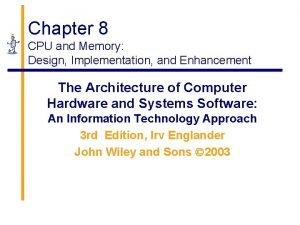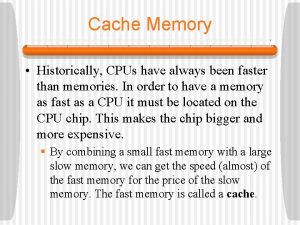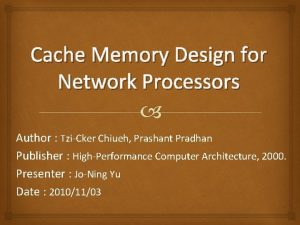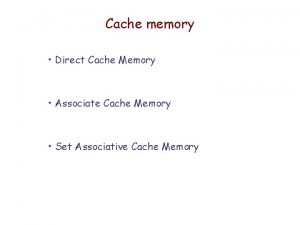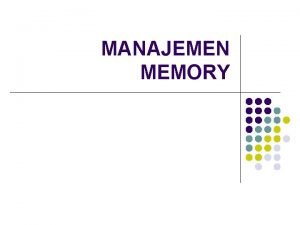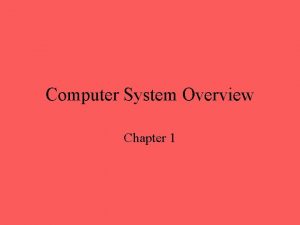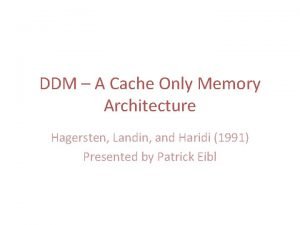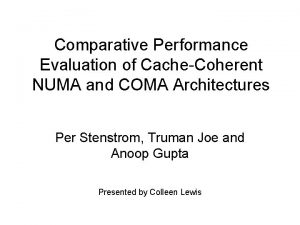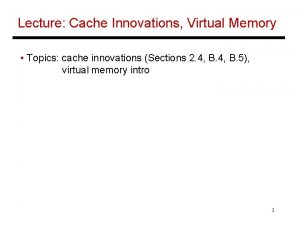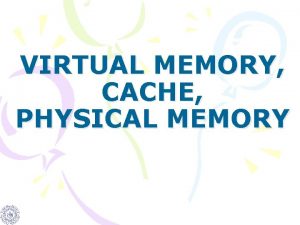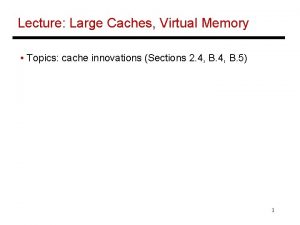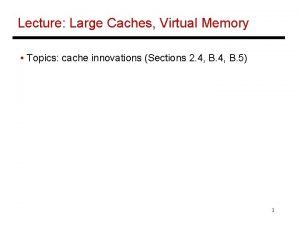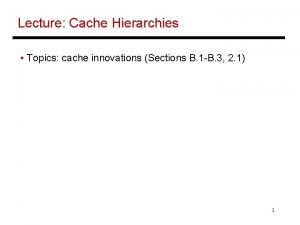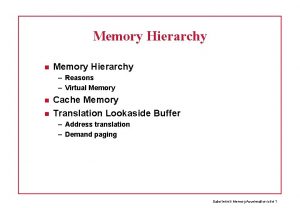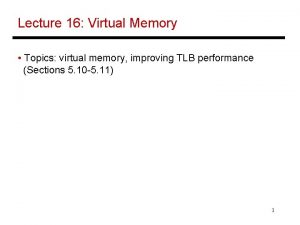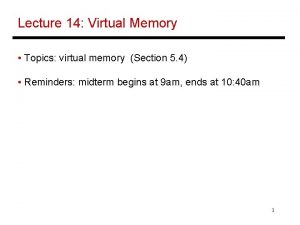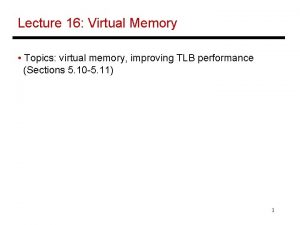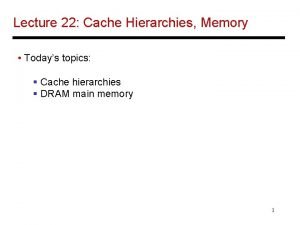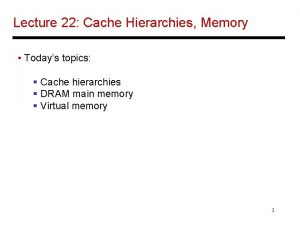Lecture Cache Innovations Virtual Memory Topics cache innovations




















- Slides: 20

Lecture: Cache Innovations, Virtual Memory • Topics: cache innovations (Sections 2. 4, B. 5), virtual memory intro 1

Types of Cache Misses • Compulsory misses: happens the first time a memory word is accessed – the misses for an infinite cache • Capacity misses: happens because the program touched many other words before re-touching the same word – the misses for a fully-associative cache • Conflict misses: happens because two words map to the same location in the cache – the misses generated while moving from a fully-associative to a direct-mapped cache • Sidenote: can a fully-associative cache have more misses than a direct-mapped cache of the same size? 2

What Influences Cache Misses? Compulsory Capacity Conflict Increasing cache capacity Increasing number of sets Increasing block size Increasing associativity 3

Reducing Miss Rate • Large block size – reduces compulsory misses, reduces miss penalty in case of spatial locality – increases traffic between different levels, space waste, and conflict misses • Large cache – reduces capacity/conflict misses – access time penalty • High associativity – reduces conflict misses – rule of thumb: 2 -way cache of capacity N/2 has the same miss rate as 1 -way cache of capacity N – more energy 4

More Cache Basics • L 1 caches are split as instruction and data; L 2 and L 3 are unified • The L 1/L 2 hierarchy can be inclusive, exclusive, or non-inclusive • On a write, you can do write-allocate or write-no-allocate • On a write, you can do writeback or write-through; write-back reduces traffic, write-through simplifies coherence • Reads get higher priority; writes are usually buffered • L 1 does parallel tag/data access; L 2/L 3 does serial tag/data 5

Tolerating Miss Penalty • Out of order execution: can do other useful work while waiting for the miss – can have multiple cache misses -- cache controller has to keep track of multiple outstanding misses (non-blocking cache) • Hardware and software prefetching into prefetch buffers – aggressive prefetching can increase contention for buses 6

Techniques to Reduce Cache Misses • Victim caches • Better replacement policies – pseudo-LRU, NRU • Prefetching, cache compression 7

Victim Caches • A direct-mapped cache suffers from misses because multiple pieces of data map to the same location • The processor often tries to access data that it recently discarded – all discards are placed in a small victim cache (4 or 8 entries) – the victim cache is checked before going to L 2 • Can be viewed as additional associativity for a few sets that tend to have the most conflicts 8

Replacement Policies • Pseudo-LRU: maintain a tree and keep track of which side of the tree was touched more recently; simple bit ops • NRU: every block in a set has a bit; the bit is made zero when the block is touched; if all are zero, make all one; a block with bit set to 1 is evicted 9

Prefetching • Hardware prefetching can be employed for any of the cache levels • It can introduce cache pollution – prefetched data is often placed in a separate prefetch buffer to avoid pollution – this buffer must be looked up in parallel with the cache access • Aggressive prefetching increases “coverage”, but leads to a reduction in “accuracy” wasted memory bandwidth • Prefetches must be timely: they must be issued sufficiently in advance to hide the latency, but not too early (to avoid 10 pollution and eviction before use)

Stream Buffers • Simplest form of prefetch: on every miss, bring in multiple cache lines • When you read the top of the queue, bring in the next line Sequential lines L 1 Stream buffer 11

Stride-Based Prefetching • For each load, keep track of the last address accessed by the load and a possibly consistent stride • FSM detects consistent stride and issues prefetches incorrect init steady correct incorrect (update stride) correct PC correct tag prev_addr stride state correct trans no-pred incorrect (update stride) 12

Shared Vs. Private Caches in Multi-Core • What are the pros/cons to a shared L 2 cache? P 1 P 2 P 3 P 4 L 1 L 1 L 2 L 2 L 2 13

Shared Vs. Private Caches in Multi-Core • Advantages of a shared cache: § Space is dynamically allocated among cores § No waste of space because of replication § Potentially faster cache coherence (and easier to locate data on a miss) • Advantages of a private cache: § small L 2 faster access time § private bus to L 2 less contention 14

UCA and NUCA • The small-sized caches so far have all been uniform cache access: the latency for any access is a constant, no matter where data is found • For a large multi-megabyte cache, it is expensive to limit access time by the worst case delay: hence, non-uniform cache architecture 15

Large NUCA Issues to be addressed for Non-Uniform Cache Access: • Mapping CPU • Migration • Search • Replication 16

Shared NUCA Cache Core 0 L 1 D$ Core 1 L 1 I$ L 1 D$ L 2 $ Core 4 L 1 D$ L 1 I$ L 1 D$ L 2 $ Core 5 L 1 I$ Core 2 L 1 I$ L 2 $ L 1 I$ Core 3 L 1 D$ L 2 $ Core 6 L 1 D$ L 1 I$ A single tile composed of a core, L 1 caches, and a bank (slice) of the shared L 2 cache Core 7 L 1 D$ L 2 $ Memory Controller for off-chip access L 1 I$ L 2 $ The cache controller forwards address requests to the appropriate L 2 bank and handles coherence operations

Virtual Memory • Processes deal with virtual memory – they have the illusion that a very large address space is available to them • There is only a limited amount of physical memory that is shared by all processes – a process places part of its virtual memory in this physical memory and the rest is stored on disk • Thanks to locality, disk access is likely to be uncommon • The hardware ensures that one process cannot access the memory of a different process 18

Address Translation • The virtual and physical memory are broken up into pages 8 KB page size Virtual address virtual page number Translated to phys page number 13 page offset Physical address physical page number 13 page offset Physical memory 19

Title • Bullet 20
 Page fault
Page fault Virtual memory in memory hierarchy consists of
Virtual memory in memory hierarchy consists of 01:640:244 lecture notes - lecture 15: plat, idah, farad
01:640:244 lecture notes - lecture 15: plat, idah, farad Termasuk operasi pembacaan cache memory
Termasuk operasi pembacaan cache memory Contoh cache memory
Contoh cache memory Cache
Cache Rom ram cache
Rom ram cache Disadvantages of fully associative cache
Disadvantages of fully associative cache Cache vs memory
Cache vs memory Computer memory system overview
Computer memory system overview Cache vs memory
Cache vs memory They've always been faster
They've always been faster Cache memory design
Cache memory design Cache memory adalah
Cache memory adalah Cache memory organization
Cache memory organization Cache memory organization
Cache memory organization Makalah manajemen memori
Makalah manajemen memori Cache memory is invisible to the os.
Cache memory is invisible to the os. Cache only memory architecture
Cache only memory architecture Cache only memory architecture
Cache only memory architecture Shape memory alloys lecture notes
Shape memory alloys lecture notes



